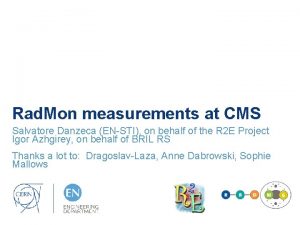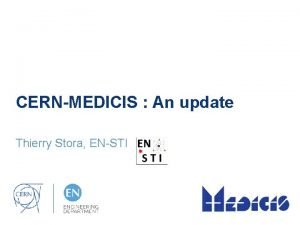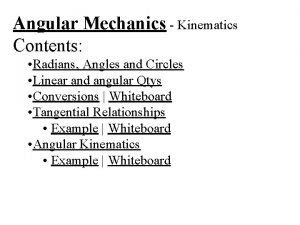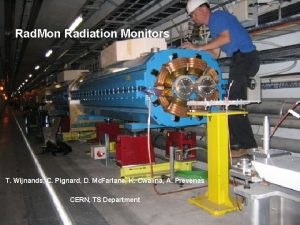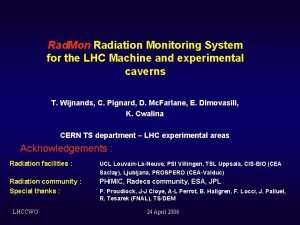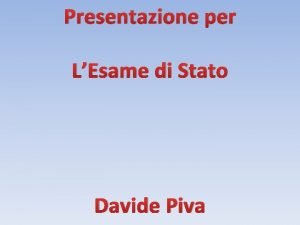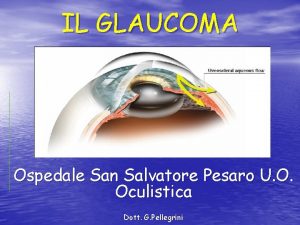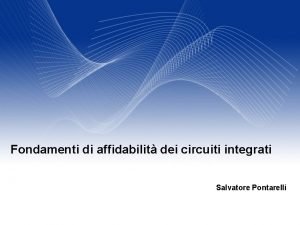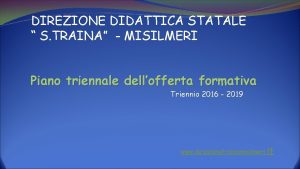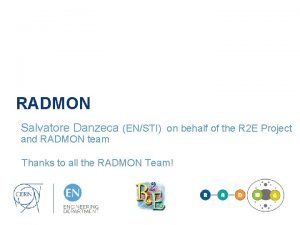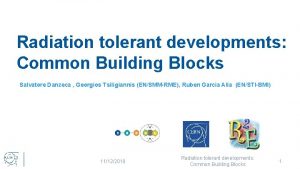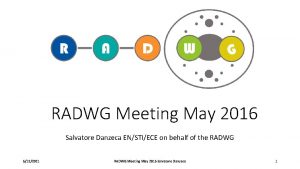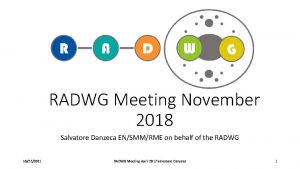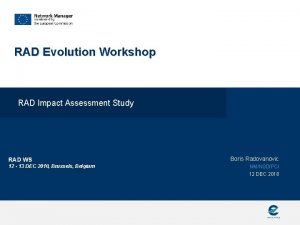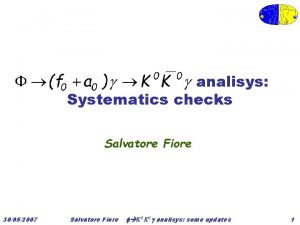Rad Mon measurements at CMS Salvatore Danzeca ENSTI











- Slides: 11

Rad. Mon measurements at CMS Salvatore Danzeca (EN-STI), on behalf of the R 2 E Project Igor Azhgirey, on behalf of BRIL RS Thanks a lot to: Dragoslav-Laza, Anne Dabrowski, Sophie Mallows

Radiation Level measured in CMS: LAYOUT • 19 Rad. Mons V 4/V 5 are installed in CMS UXC 55 cavern 10/3/2020 Rad. Mon measurements at CMS (UXC 55) 2

Radiation Level measured in CMS: LAYOUT 10/3/2020 Rad. Mon measurements at CMS (UXC 55) 3

Luminosity driven • The radiation levels are luminosity driven • No effects when no collisions CMS Luminosity Intensity Rad. Mon LE 09 10/3/2020 Rad. Mon measurements at CMS (UXC 55) 4

UXC 55 mapping • 2016 measurements • R factor is calculated from FLUKA simulations • The uncertainty is dominated by the R factor calculations ~factor 2 • Maximum Fluence 2016 is 3. 79 e 9 HEH/cm 2 • Good agreement with the FLUKA simulations • CMS FLUKA Study v 3. 15. 0. 0 R factor 5 LE 02 5 LE 03 5 LE 04 5 LE 05 5 LE 07 5 LE 08 5 LE 09 5 LE 10 5 RE 01 5 RE 02 5 RE 03 5 RE 04 5 RE 05 5 RE 06 5 RE 07 5 RE 09 5 RE 10 10/3/2020 19 3 4. 4 1. 2 1. 9 2. 4 0. 7 1. 1 2. 3 2. 5 1. 5 5. 5 20 6. 6 0. 7 HEH/cm 2 Rad. Mon Fluka 1. 72 E+07 6. 93 E+07 4. 65 E+08 5. 61 E+08 2. 64 E+08 4. 29 E+08 1. 34 E+09 3. 23 E+09 7. 03 E+08 1. 29 E+09 7. 11 E+08 9. 90 E+08 1. 93 E+09 7. 26 E+09 3. 79 E+09 4. 62 E+09 4. 97 E+06 LOW STAT 8. 37 E+08 1. 29 E+09 7. 06 E+08 1. 06 E+09 1. 35 E+09 3. 14 E+09 2. 35 E+08 3. 63 E+08 1. 06 E+07 6. 60 E+07 9. 04 E+07 2. 05 E+08 1. 84 E+09 7. 26 E+09 4. 77 E+07 LOW STAT Rad. Mon measurements at CMS (UXC 55) Diff % -75. 18 -17. 19 -38. 41 -58. 52 -45. 38 -28. 23 -73. 35 -17. 88 -34. 94 -33. 13 -56. 94 -35. 15 -83. 97 -55. 83 -74. 61 5

Proton run comparison 2015/2016 and previsions • The radiation levels scale proportionally with the integrated luminosity • 2015 and 2016 are in very good agreement ~15% • We can extrapolate those values for the HL-LHC era Low statistics 5 LE 02 5 LE 03 5 LE 04 5 LE 05 5 LE 07 5 LE 08 5 LE 09 5 LE 10 5 RE 01 5 RE 02 5 RE 03 5 RE 04 5 RE 05 5 RE 06 5 RE 07 5 RE 09 5 RE 10 HEH/cm 2/fb-1 2016 4. 30 E+05 1. 16 E+07 6. 61 E+06 3. 35 E+07 1. 76 E+07 1. 78 E+07 4. 84 E+07 9. 48 E+07 1. 24 E+05 2. 09 E+07 1. 77 E+07 3. 37 E+07 5. 89 E+06 2. 65 E+05 2. 26 E+06 4. 61 E+07 1. 19 E+06 10/3/2020 HEH/cm 2/fb-1 2015 4. 69 E+05 9. 80 E+06 6. 24 E+06 3. 11 E+07 1. 74 E+07 1. 56 E+07 3. 89 E+07 9. 94 E+07 2. 30 E+05 2. 34 E+07 1. 84 E+07 3. 64 E+07 5. 99 E+06 2. 54 E+05 2. 50 E+06 4. 75 E+07 3. 23 E+06 Diff % 6. 18 -15. 63 -5. 47 -7. 14 -0. 78 -12. 06 -19. 56 4. 82 85. 61 11. 67 4. 15 7. 88 1. 72 -4. 05 10. 78 3. 10 170. 69 HEH/cm 2 2016 (40 fb-1) 1. 72 E+07 4. 65 E+08 2. 64 E+08 1. 34 E+09 7. 03 E+08 7. 11 E+08 1. 93 E+09 3. 79 E+09 4. 97 E+06 8. 37 E+08 7. 06 E+08 1. 35 E+09 2. 35 E+08 1. 06 E+07 9. 04 E+07 1. 84 E+09 4. 77 E+07 HL-LHC 300 fb-1 1. 33 E+08 3. 48 E+09 1. 98 E+09 1. 01 E+10 5. 27 E+09 5. 33 E+09 1. 45 E+10 2. 85 E+10 3. 73 E+07 6. 28 E+09 5. 30 E+09 1. 01 E+10 1. 77 E+09 7. 94 E+07 6. 78 E+08 1. 38 E+10 3. 58 E+08 Rad. Mon measurements at CMS (UXC 55) 6

Conclusions • Rad. Mon Analysis • • • Map of the cavern in the Rad. Mon location Maximum Fluence 2016 3. 79 e 9 HEH/cm 2 Good agreement with the simulations Consistent measurements scaled with luminosity between 2015 and 2016 HEH fluence per year can be a constraint for the HL-LHC era • Outlooks • • • Two Rad. Mons will be switched to 5 V during the EYETS 2017 to measure the R factor and compare it with the Fluka simulations It could be useful to have the equipment failures in the cavern to sort out the sensitive equipment Possibility of assessing a system failure rate in a representative environment at CHARM 10/3/2020 Rad. Mon measurements at CMS (UXC 55) 7

Thank you

TID Measurements • The TID is measured by means of a silicon dosimeter Rad. Fet • The TID levels are really low < 1 Gy 5 LE 02 S 5 LE 03 S 5 LE 04 S 5 LE 05 S 5 LE 07 S 5 LE 08 S 5 LE 09 S 5 LE 10 S 5 RE 01 S 5 RE 02 S 5 RE 03 S 5 RE 04 S 5 RE 05 S 5 RE 06 S 5 RE 07 S 5 RE 09 S 5 RE 10 S 10/3/2020 TID [Gy] 0. 005 0. 019 0. 022 0. 049 0. 034 0. 053 0. 201 0. 003 0. 032 0. 034 0. 061 0. 019 0. 005 0. 01 0. 044 0 Rad. Mon measurements at CMS (UXC 55) 9

CMS FLUKA Model v. 3. 15. 0. 0 Rad. Mons positions were described with some approximation by 1 m 3 scoring volumes. Hall model does not include most of the CMS infrastructure (cables e. t. c. ) – underestimation of Fth is possible (and overestimation of biased experimental Fh). Description of hall concrete is a question (neutron moderation capability depends on H content and humidity)

Typical neutron energy spectra Hard (~ R 04, Rth = 1. 5) Intermediate (~ R 05, Rth = 5. 5) Soft (~ L 02/R 06, Rth near 20)
